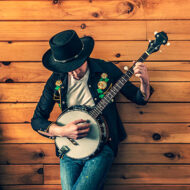Ballpoint Pen Art
Beautiful Works of Art in a Most Unforgiving Medium
Ballpoint pen art always intimidated me. Back in 2014, when I took on the challenge to do a daily sketch, a friend cautioned me with regards to using pencil. This sketchbook was to be with me at all times, bounced around in my backpack, squished between other items, etc. He warned me based on his own experience that pencil smears and you lose a lot of detail in the wear and tear of your sketchbook. The solution? Use a ballpoint pen.
Pen? Really?? But, you can’t erase pen! When it came right down to it, I couldn’t see any way around it. I had to use pen. When the day came for me to start, January 1, 2014, I sat there with my pen poised, just hovering over the pristine blank page of my brand new sketchbook. I was practically frozen with fear. What if I made a mistake? “Simple…” the voice in my head told me. “Don’t make any!” Gee, thanks.

My April 29, 2014 ballpoint pen sketch.
Eventually, I made the first mark…and then another. Before I knew it, 2014 had passed and I had a sketchbook filled with animal portraits. Some of them were better than others. All of them were done in pen. I had done the impossible! I’m quite proud of that little sketchbook.

Incredible work by Samuel Silva!
The experience has opened my eyes to other artists who do much more refined and polished portraits…in color pen. Artists like Samuel Silva, for example. He’s not a professional artist either. He’s actually an attorney and art is a hobby. He doesn’t use any fancy art pens, just your typical color Bic pens that you can get in any Staples or office supply store. The same is true for Scott Mackie, ballpoint pen artist from Aberdeen, Scotland.

Artist Scott Mackie draws his incredible works on old publications.
Simple Bic pens? Yes, your typical office variety. Other artists use Papermate or a combination of cheap office pens as well as the fancier artists’ pens. If you’re starting out, just know that you don’t have to invest your life savings in supplies. So maybe try out some of the cheap ones first. If you really don’t like working with pens, at least you’ll only be out a few bucks.

No need to spend a boatload of cash! Simple office supply pens will do.
Is there a technique to using ballpoint pens? Most definitely. Most artists I’ve come across online use a crosshatching technique. For me, since most of the portraits I create are of animals with fur or feathers, I can skip the crosshatching and just use careful strokes in the direction of the fur. Artists like Samuel Silva boggle my mind with how smooth they can crosshatch. Other artists don’t use the crosshatching method and opt for just hatching in just one direction, like artist, Gareth Edwards.
In addition, they are also layering different colors to get the colors they want. Obviously, Bic and Papermate don’t come in 120 different colors like a Prismacolor set of colored pencils. But with careful layering, they can get any color they need, including flesh tones.
Make Ballpoint Pen Tip Wiping Habitual!
But no matter the technique used, habitual wiping of the pen tip is absolutely necessary. I learned pretty early on in my ballpoint pen experience that nothing was more frustrating than having a drawing nearly done and having that evil blob ruin the piece. So, it became a necessity to have a napkin in my backpack along with my sketchbook and pens. It didn’t take long to learn to wipe the pen tip on the napkin every 2-3 minutes. And it’s not a matter of getting a more expensive pen. It’s really the way ballpoint pens are designed. As the ink flows around the ball in the tip of the pen, it accumulates. When it builds up enough, it will unceremoniously dump it right onto your masterpiece. So get in the habit of wiping your pens!
Overall, my personal experience with ballpoint pens was surprisingly satisfying (aside from evil ink blobs) and not as scary as I thought it would be. My 2014 sketchbook isn’t the least bit smudged and hasn’t lost any detail whatsoever. If you’ve been contemplating working with ballpoint pens, stop contemplating and give it whirl!
This blog contains Amazon Affiliate links. As an Amazon Associate, I may earn from qualifying purchases.



Recent Comments